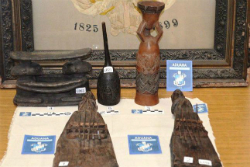Argentina’s authorities captured two separate contraband traders moving historic artifacts and stolen artworks across the Argentine-Uruguay border in a sign that the underworld art trade continues to thrive.
The suspects — who were captured by the Argentine customs agency (known by its acronym AFIP) in separate vehicles at a prominent border crossing — were moving ancient books, weapons, musical instruments and paintings, among other items, Clarin reported.
At least three of the books were printed by Jesuit missionaries in the 17th Century; the artwork was more recent and included items from the Lebanese artist Bibi Zogbe?s collection of paintings, La Nacion said.
Authorities believe the artifacts and art were headed to Europe via Montevideo, Clarin added.
InSight Crime Analysis
While seemingly only impacting elite collectors and museums, the underworld trade in art and artifacts is hardly benign. Drug traffickers long ago discovered the utility of laundering money through the purchase and sale of black market art. And gunrunners, among others, use it as collateral for weapons deals.
One of the more infamous of these underworld figures was Fidel Castaño. Castaño created a feared right-wing paramilitary organization that was the precursor to the United Self-defense Groups of Colombia (AUC), and he was one of the founders of the organization known as People Persecuted by Pablo Escobar (PEPES), the paramilitary group that helped authorities track and eventually kill Pablo Escobar in December 1993.
Castaño was also an avid collector of paintings and sculptures. One of his favorites was the Ecuadorean artist Oswaldo Guayasamin, who he commissioned to paint his portrait. (See below) Castaño — who also owned vast numbers of cattle and had his hands in numerous other businesses — once told his underworld cohorts that trafficking art was more lucrative than drug trafficking.

While this claim is probably a stretch, the black market of art and artifacts is significant. And in this highly inter-connected modern world, the $6 billion trade in artifacts and stolen artwork shows little sign of abating in the Americas. From Peru?s patrimonial artifacts to Guatemala?s religious art, there is no shortage of contraband to be traded.
Castaño?s fate, much like the paintings he trafficked, remains a mystery. While his younger brother, Carlos, said that Fidel was killed in an ambush by leftist rebels, others claim he is still alive and living in Portugal, where he is supposedly an art dealer.

